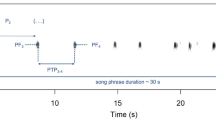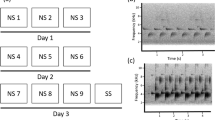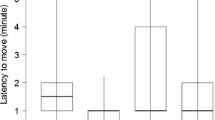Abstract
Neighbour recognition allows territory owners to modulate their territorial response according to the threat posed by each neighbour and thus to reduce the costs associated with territorial defence. Individual acoustic recognition of neighbours has been shown in numerous bird species, but few of them had a large repertoire. Here, we tested individual vocal recognition in a songbird with a large repertoire, the skylark Alauda arvensis. We first examined the physical basis for recognition in the song, and we then experimentally tested recognition by playing back songs of adjacent neighbours and strangers. Males showed a lower territorial response to adjacent neighbours than to strangers when we broadcast songs from the shared boundary. However, when we broadcast songs from the opposite boundary, males showed a similar response to neighbours and strangers, indicating a spatial categorisation of adjacent neighbours’ songs. Acoustic analyses revealed that males could potentially use the syntactical arrangement of syllables in sequences to identify the songs of their neighbours. Neighbour interactions in skylarks are thus subtle relationships that can be modulated according to the spatial position of each neighbour.


Similar content being viewed by others
References
Aubin T (1981) Etude expérimentale du chant territorial de l’alouette des champs (Alauda arvensis L.). Caractéristiques physiques, valeur sémantique et spécificité. Ph.D. thesis, University of Besançon, Nancy 1, Strasbourg
Aubin T (1982) Habituation au chant territorial chez l’alouette des champs (Alauda arvensis L.). Biol Behav 7:353–362
Aubin T, Brémond J-C (1983) The process of species-specific song recognition in the skylark Alauda arvensis. An experimental study by means of synthesis. Z Tierpsychol 61:141–152
Aubin T, Mathevon N, Silva ML, Vielliard JME, Sebe F (2004) How a simple and stereotyped acoustic signal transmits individual information: the song of the White-browed Warbler Basileuterus leucoblepharus. An Acad Bras Ciênc 76:335–344
Bee MA (2003) A test of the “dear-enemy effect” in the strawberry dart-poison frog (Dendrobates pumilio). Behav Ecol Sociobiol 54:601–610. doi:10.1007/s00265-003-0657-5
Bee MA, Gerhardt HC (2001) Neighbour-stranger discrimination by territorial male bullfrogs, Rana catesbeiana: II perceptual basis. Anim Behav 62:1141–1150. doi:10.1006/anbe.2001.1852
Becker PH (1974) Der Gesang von Winter- und Sommergoldhähnchen (Regulus regulus, R. ignicapillus) am westlichen Bodensee. Vögelwarte 27:233–243
Bergmann HH, Klaus S, Müller F, Wiesner J (1975) Individualität und Artspezifität in den Gesangsstrophen einer Population des Haselhuhns (Binasa bonasia bonasia L., Tetraoninae, Phasianidae). Behaviour 55:97–116
Bjerke T (1971) Song variation in the tree pipit, Anthus trivialis. Sterra 10:97–116
Briefer E, Aubin T, Lehongre K, Rybak F (2008a) How to identify dear-enemies: the group signature in the complex song of the skylark Alauda arvensis. J Exp Biol 211:317–326. doi:10.1242/jeb.013359
Briefer E, Rybak F, Aubin T (2008b) When to be a dear-enemy: flexible acoustic relationships of neighbouring skylark Alauda arvensis. Anim Behav 76:1319–1325. doi:10.1016/j.anbehav.2008.06.017
Brindley EL (1991) Response of European robins to playback of song: neighbor recognition and overlapping. Anim Behav 41:503–512. doi:10.1016/S0003-3472(05)80853-X
Catchpole CK, Slater PJ (eds) (1995) Bird song: biological themes and variations. Cambridge University Press, Cambridge, pp 45–69
Craig C (2000) Goldwave v5.11. Goldwave, St John’s
Delius JD (1963) Das Verhalten der Feldlerche. Z Tierpsychol 20:297–348
Emlen ST (1972) An experimental analysis of the parameters of bird song eliciting species recognition. Behaviour 41:130–171
Falls JB (1982) Individual recognition by sound in birds. In: Kroodsma DE, Miller EH (eds) Acoustic communication in birds II. Academic, New York, pp 237–274
Falls JB, Brook RJ (1975) Individual recognition by song in white-throated sparrows II: effect of location. Can J Zool 53:1412–1420
Falls JB, McNicholl MK (1979) Neighbour-stranger discrimination by song in male blue grouse. Can J Zool 57:457–462. doi:10.1139/cjz-57-2-457
Fisher J (1954) Evolution and bird sociality. In: Huxley J, Hardy AC, Ford EB (eds) Evolution as a process. Allen and Unwin, London, pp 71–83
Gentner TQ, Hulse SH (1998) Perceptual mechanisms for individual vocal recognition in european starlings, Sturnus vulgaris. Anim Behav 56:579–594. doi:10.1006/anbe.1998.0810
Godard R (1991) Long-term memory of individual neighbors in a migratory songbird. Nature 350:228–229. doi:10.1038/350228a0
Godard R (1993) Tit for tat among neighboring hooded warblers. Behav Ecol Sociobiol 33:45–50. doi:10.1007/BF00164345
Hedenström A (1995) Song flight performance in the skylark Alauda arvensis. J Avian Biol 26:337–342
Hultsch H, Todt D (1989) Context memorization in the song-learning of birds. Naturwissenschaften 76:584–586
Hyman J, Hughes M (2006) Territory owners discriminate between aggressive and nonaggressive neighbours. Anim Behav 72:209–215. doi:10.1016/j.anbehav.2006.01.007
Jenny M (1990) Populationsdynamik der Feldlerche Alauda arvensis in einer intensiv genutzten Agrarlandschaft des schweizerischen Mittellandes. Orn Beob 87:153–163
Krebs JR, Kroodsma DE (1980) Repertoire and geographical variation in bird song. In: Rosenblatt JS, Hinde RA, Beer C, Busnel MC (eds) Advances in the study of behaviour II. Academic, New York, pp 134–177
Lachenbruch PA, Mickey MR (1968) Estimation of error rates in discriminant analysis. Technometrics 10:1–11
Lambrechts MM, Dhondt AA (1995) Individual voice discrimination in birds. Curr Ornithol 12:115–139
Lehongre K, Aubin T, Robin S, Del Negro C (2008) Individual signature in canary songs: contribution of multiple levels of song structure. Ethology 114:425–435. doi:10.1111/j.1439-0310.2008.01486.x
Leiser JK, Itzkowitz M (1999) The benefit of the dear enemy recognition in three-contender convict cichlid (Cichlasoma nigrofasciatum) contests. Behaviour 136:983–1003. doi:10.1163/156853999501685
Lovell SF, Lein MR (2005) Individual recognition by song in a suboscine bird, the alder flycatcher Empidonax alnorum. Behav Ecol Sociobiol 57:623–630. doi:10.1093/beheco/arh082
Marler P (1960) Bird songs and mate selection. In: Tavolga WN (ed) Animal sounds and communication. A.I.B.S. Symposium Proceedings, Washington DC, pp 348–367
McGregor PK (1992) Playback and studies of animal communication. In: McGregor PK (ed) Quantifying responses to playback: one, many, or composite multivariate measures. Plenum, New York, pp 79–96
McGregor PK, Catchpole CK, Dabelsteen T (1992) Design of playback experiments: the Thornbridge Hall NATO ARW consensus. In: McGregor PK (ed) Playback and studies of animal communication. Plenum, New York, pp 1–9
Mundry R (1999) Testing related samples with missing values: a permutation approach. Anim Behav 58:1143–1153. doi:10.1006/anbe.1999.1246
Naguib M (2005) Singing interactions in songbirds: implications for social relations and territorial settlement. In: McGregor P (ed) Animal Communication Networks. University Press, Cambridge, pp 300–319
Naguib M, Todt D (1998) Recognition of neighbors song in a species with large and complex song repertoires—the thrush nightingale. J Avian Biol 2:155–160. doi:10.2307/3677193
Nelson DA, Poesel A (2007) Segregation of information in a complex acoustic signal: Individual and dialect identity in white-crowned sparrow song. Anim Behav 74:1073–1084. doi:10.1016/j.anbehav.2007.01.018
Olendorf R, Getty T, Scribner K, Robinson SK (2003) Males red-winged black birds distrust unreliable and sexually attractive neighbours. Proc R Soc B 271:1033–1038. doi:10.1098/rspb.2004.2687
Poesel A, Dabelsteen T, Darden S-K, Dehley K, Peters A (2007) Territorial responses of male blue tits, Cyanistes caeruleus, to UV-manipulated neighbours. J Ornithol 148:179–187. doi:10.1007/s10336-006-0117-x
R Development Core Team (2007) R: A language and environment for statistical computing. R Foundation for Statistical Computing, Vienna, Austria. ISBN 3-900051-07-0. Accessed at http://www.R-project.org
Robisson P, Aubin T, Brémond J-C (1993) Individuality in the voice of emperor penguin Aptenodytes forsteri: adaptation to a noisy environment. Ethology 94:279–290
Scherrer B (1984) Biostatistique. Gaëtan Morin, Chicoutimy, p 850
Schubert M (1969) Untersuchung über die akustischen Parameter von Zilpzalp-Fitis-Mischgesangen. Beitr Vogelkd 14:354–368
Sokal RR, Rohlf FJ (1995) Biometry: the principles and practice of statistics in biological research, 3rd edn. Freeman, New York 887p
Specht R (2004) Avisoft-SASLab pro v4.31. Avisoft. Berlin
StatSoft Inc. (2001) Statistica v6.0. for Windows (Computer program manual). StatSoft Inc. Tulsa
Stoddard PK (1996) Vocal recognition of neighbors by territorial Passerines. In: Kroodsma DE, Miller EH (eds) Ecology and evolution of acoustic communication in birds. Cornell University Press, Ithaca, pp 356–374
Stoddard PK, Beecher MD, Loesche P, Campbell ES (1992) Memory does not constrain individual recognition in a bird with song repertoires. Behaviour 122:274–287. doi:10.1163/156853992X00543
Temeles EJ (1994) The role of neighbours in territorial systems: when are they ‘dear enemies’? Anim Behav 47:339–350. doi:10.1006/anbe.1994.1047
Tibbetts EA, Dale J (2007) Individual recognition: it is good to be different. Trends Ecol Evol 22:529–537. doi:10.1016/j.tree.2007.09.001
Thomson AD, Baker MC (1993) Song dialect recognition by male white-crowned sparrows: effects of manipulated song components. Condor 95:414–421
Thomson RF, Spencer WA (1966) Habituation: a model phenomenon for the study of neuronal substrates of behaviour. Psychol Rev 73:16–43
Weary DM, Krebs JR (1992) Great tits classify songs by individual voice characteristics. Anim Behav 43:283–287
Acknowledgements
This study was supported by the CNRS and the University of Paris 11. EB is funded by a grant from the French Minister of Research and Technology. We thank Katia Lehongre for running the custom Matlab programme and Joel White for English improvement. We are grateful to the anonymous referees for comments and suggestions. The experiments comply with the current laws of France.
Author information
Authors and Affiliations
Corresponding author
Rights and permissions
About this article
Cite this article
Briefer, E., Aubin, T. & Rybak, F. Response to displaced neighbours in a territorial songbird with a large repertoire. Naturwissenschaften 96, 1067–1077 (2009). https://doi.org/10.1007/s00114-009-0567-0
Received:
Revised:
Accepted:
Published:
Issue Date:
DOI: https://doi.org/10.1007/s00114-009-0567-0




